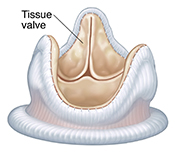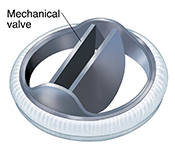Having Minimally Invasive Mitral Valve Replacement
The mitral valve allows blood to flow from the left atrium to the left ventricle in the heart. A mitral valve replacement is a surgery to replace a mitral valve that doesn’t work well. Minimally invasive surgery is done with small incisions and special small tools. This may lead to an easier and faster recovery from surgery.
Choosing a new valve
Before the surgery, you and your healthcare provider will talk about what kind of valve will work best for you. You may be given a biological valve. This is a valve made from animal or human heart tissue. Or you may be given a mechanical valve. This is an artificial valve made from metal and other materials.
Each type of valve has different risks and benefits. Biological valves may need to be replaced in 10 to 20 years. Mechanical valves are more durable and can last for a very long time, but you need to take blood thinner medicine for life. This is to help prevent clots that can form on the valve and may cause stroke or the functioning part of the valve to become frozen. Make sure to talk with your healthcare provider about the kinds of follow-up care needed for each type.


What to tell your healthcare provider
Tell your healthcare provider about all the medicines you take. This includes over-the-counter medicines, such as ibuprofen. It also includes vitamins, herbs, other supplements, or recreational drugs. And tell your healthcare team if you:
-
Have had any recent changes in your health, such as an infection or fever
-
Are sensitive or allergic to any medicines, latex, tape, or anesthesia (local and general)
-
Are pregnant or think you may be pregnant
Tests before your surgery
Before your surgery, you may need tests, such as:
-
Chest X-ray
-
Electrocardiogram (ECG), to check the heart’s rhythm
-
Blood tests to look at your general health
-
Echocardiogram to view heart anatomy and blood flow through the heart
-
Coronary angiogram to look at blood flow in your heart’s arteries
Getting ready for your surgery
Talk with your healthcare provider about how to get ready for your surgery. You may need to stop taking some medicines before the surgery, such as blood thinners and aspirin. If you smoke, you may need to stop before your surgery. Smoking can slow healing. Talk with your healthcare provider if you need help to stop smoking.
Also, make sure to do the following:
-
Ask a family member or friend to take you home from the hospital. Don't drive yourself.
-
Plan some changes at home to help you recover. You may need help at home.
-
Follow any directions you are given for not eating or drinking before surgery.
-
Follow all other instructions from your healthcare provider.
You will be asked to sign a consent form that gives your permission to do the surgery. Read the form carefully. Ask questions if something is not clear.
On the day of surgery
Your procedure will be done by a cardiac surgeon. This is a doctor who treats diseases of the heart. They will work with a team of specialized nurses and operating room staff. The surgery can be done in more than one way. Some surgeons use robot-controlled arms to do the surgery. Talk with your healthcare provider about the risks and benefits of this kind of surgery. The surgery will take several hours. In general, you can expect the following:
-
You will have general anesthesia, which is medicine that allows you to sleep through the surgery. You won’t feel any pain during the surgery.
-
You will be hooked up to a heart-lung machine. This machine will act as your heart and lungs during the surgery.
-
A healthcare provider will watch your vital signs, like your heart rate and blood pressure, during the surgery.
-
The surgeon makes a small 2- to 4-inch incision in your chest to access the heart. The incision may be through the breastbone, to the right of your breastbone, or between the ribs on your side.
-
The surgeon puts special small tools and a tiny camera through the incision. They remove your mitral valve and replace it with a new valve.
-
The surgery team will take you off the heart-lung machine.
-
The team closes all incisions with stitches, staples, or both. The team puts dressings on the incisions.
After your surgery
After surgery, you will be taken to a recovery room or directly to an intensive care unit (ICU). Nurses will check your breathing, heart rate, and blood pressure. You may have a tube draining fluid from your chest. You may have a tube in your throat to help you breathe. This may be uncomfortable, and you won’t be able to talk. The tube is usually removed within 24 hours. You may stay in the hospital for 3 to 5 days.
You may have some pain at the incision site after surgery. You can take pain medicines to help relieve it. Only take pain medicine approved by your healthcare provider.
In a day or two, you should be able to sit in a chair and walk with help. You may need to do breathing therapy to help prevent or remove fluid building up in your lungs. You can go back to your normal food as soon as you feel able.
When you go home, it may take a little while for you to go back to your normal activities. Make sure you have someone to help at home during this time. Don't do any vigorous exercise until your healthcare provider says you are ready. Don’t lift anything heavy until your healthcare provider says it’s OK. Ask your healthcare provider when it is safe for you to drive.
Take your temperature and weigh yourself every day. This is to check for infection, and to make sure your heart is pumping normally. If it doesn’t pump normally, fluid can build up in your body and cause excess weight quickly.
Follow-up care
You will probably have your stitches or staples removed in 7 to 10 days. Make sure you keep all of your follow-up appointments. Follow all the instructions your healthcare provider gives you for medicines, exercise, diet, and wound care. Don't get the incision wet until your healthcare provider gives you permission to do so. Don't drive or do vigorous exercise or lifting until your healthcare provider says it's OK.
Make sure all your dentists and healthcare providers know about your new heart valve. You may need to take antibiotics before certain medical and dental procedures. This is to prevent getting an infection in your new valve.
If you have a mechanical valve, you will need to take blood-thinner medicine. This is medicine that helps prevent clots. Blood thinners need frequent monitoring of levels, and certain foods and medicines can interact with these drugs. Make sure you know all about the blood thinners you are prescribed before you leave the hospital.
When to call your healthcare provider
Call your healthcare provider right away if you have any of these:
-
Fever of 100.4°F (38°C) or higher, or as directed by your healthcare provider
-
Increase in pain, redness, bleeding, or fluid leaking from the incision
-
Sudden change in weight
-
Other symptoms as advised